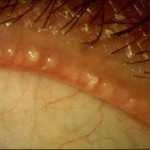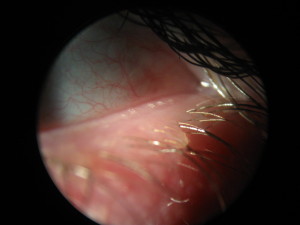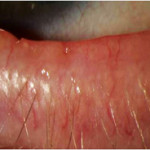As discussed in our previous post. Blepharitis has two types: Anterior Blepharitis and Posterior Blepharitis.
Today we will be discussing the posterior form.
Posterior Blepharitis
 This condition is also known as Meibomian Gland Dysfunction or simply MGD (no, not the frosty adult beverage). This form of lid inflammation occurs at the inner edge of the eyelid next to the eyeball where the meibomian (or oil producing) glands are located. As previously mentioned, these oil glands produce a very important oil that coats over the watery layer of the tears with every blink. Without proper amounts or quality of this oil the tear film becomes unstable and evaporates too quickly to keep the eye properly wetted. As a result, Posterior Blepharitis is the leading underlying cause of evaporative Dry Eye Syndrome (DES). Inflammation on this part of the eyelid results in these important oil glands clogging and become “capped” or “plugged up” as is shown above. As these oil glands get clogged, the clear oil they typically produce turns to very thick almost che
This condition is also known as Meibomian Gland Dysfunction or simply MGD (no, not the frosty adult beverage). This form of lid inflammation occurs at the inner edge of the eyelid next to the eyeball where the meibomian (or oil producing) glands are located. As previously mentioned, these oil glands produce a very important oil that coats over the watery layer of the tears with every blink. Without proper amounts or quality of this oil the tear film becomes unstable and evaporates too quickly to keep the eye properly wetted. As a result, Posterior Blepharitis is the leading underlying cause of evaporative Dry Eye Syndrome (DES). Inflammation on this part of the eyelid results in these important oil glands clogging and become “capped” or “plugged up” as is shown above. As these oil glands get clogged, the clear oil they typically produce turns to very thick almost che esy oil (shown above) along with foamy or frothy tears (right). In addition to problems with the oily layer, the natural bacterial in our tears also tends to get trapped in the clogged glands and can cause an infection of that gland; this is how stys are formed.
esy oil (shown above) along with foamy or frothy tears (right). In addition to problems with the oily layer, the natural bacterial in our tears also tends to get trapped in the clogged glands and can cause an infection of that gland; this is how stys are formed.
As this chronic inflammatory condition continues over months to years, the lids themselves continue to become more thickened and red, along with prominent engorged blood vessels and eventually the oil glands become dysfunctional all together which results in permanent scarring of the lids (photo below). Patients with Posterior Blepharitis or MGD are generally older with a long history of ocular symptoms and dry eyes. Another important note is that this condition is HIGHLY associated with Rosacea since the oil glands on the face where Rosacea occurs are very similar to the oil glands on the eyelids.
 Clearly, if left unchecked, Posterior Blepharitis can cause substantial damage to the lids and the ocular surface over time. How do we combat this process? The answer here isn’t quite so simple. This is a chronic condition and therefore, there isn’t a single treatment that works best for all patients nor is there a definite “cure”. Depending on severity, there are a few treatments that are useful in most cases. This three prong approach includes artificial tears in conjunction with proper eye lid hygiene maintenance and Omega 3 fatty acids (fish oils). For the artificial tears, it is important to improve the oily layer, therefore we recommended an emollient or “oil rich” tear like Systane Balance or Soothe XP. We have all been told since childhood to keep soap away from our eyes (and for good reason! Ouch!), however this fact in combination with the bony orbit preventing access, make the lids the only place on the human body that never gets cleaned. For our Blepharitis patients, we strongly recommend warm compresses to help loosen the clogged oil as well as routine eyelid cleaning with a dedicated (eye friendly!) cleaner like Ocusoft or Sterlid products. Omega 3 fish oils are also a natural anti-inflammatory product which will also help the lids to produce better oil, and have the added benefit of being great for heart health. As is often the case with this condition, if symptoms are more pronounced or if there is a risk of lid scarring or permanent damage, it is often necessary to go further with treatment including prescription eye drops or even oral antibiotics for several months to quell the inflammation and improve the functionality of these glands.
Clearly, if left unchecked, Posterior Blepharitis can cause substantial damage to the lids and the ocular surface over time. How do we combat this process? The answer here isn’t quite so simple. This is a chronic condition and therefore, there isn’t a single treatment that works best for all patients nor is there a definite “cure”. Depending on severity, there are a few treatments that are useful in most cases. This three prong approach includes artificial tears in conjunction with proper eye lid hygiene maintenance and Omega 3 fatty acids (fish oils). For the artificial tears, it is important to improve the oily layer, therefore we recommended an emollient or “oil rich” tear like Systane Balance or Soothe XP. We have all been told since childhood to keep soap away from our eyes (and for good reason! Ouch!), however this fact in combination with the bony orbit preventing access, make the lids the only place on the human body that never gets cleaned. For our Blepharitis patients, we strongly recommend warm compresses to help loosen the clogged oil as well as routine eyelid cleaning with a dedicated (eye friendly!) cleaner like Ocusoft or Sterlid products. Omega 3 fish oils are also a natural anti-inflammatory product which will also help the lids to produce better oil, and have the added benefit of being great for heart health. As is often the case with this condition, if symptoms are more pronounced or if there is a risk of lid scarring or permanent damage, it is often necessary to go further with treatment including prescription eye drops or even oral antibiotics for several months to quell the inflammation and improve the functionality of these glands.
It’s important to remember that there is no “cure” for Posterior Blepharitis. Sufferers from this condition need routine monitoring and sometimes aggressive treatment to maintain a comfortable and safe eye.
Stay tuned on Eye to the Future for the final installment: Anterior Blepharitis, next week.


